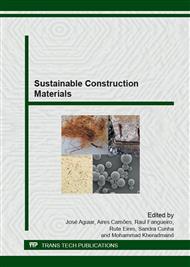[1]
H. Okamura, M. Ouchi, Self-compacting concrete, J. Adv. Concr. Technol. v. 1, n. 1 (2003) pp.5-15.
Google Scholar
[2]
N. Bouzoubaa, M. Lachemi, Self-compacting concrete incorporating high volumes of class F fly ash: preliminary results. Cem. Concr. Res. v. 31, n. 3 (2001) pp.413-420.
DOI: 10.1016/s0008-8846(00)00504-4
Google Scholar
[3]
A. Camões, Durability of high-volume fly ash concrete, International RILEM workshop on performance based evaluation and indicators for concrete durability, Madrid (2006) pp.311-318.
Google Scholar
[4]
R. Deeb, A. Ghanbari and B. Karihaloo, Development of self-Compacting high and ultra high performance concretes with and without steel fibres. Cem. Concr. Compos., v. 34, n. 2, (2012) pp.185-190.
DOI: 10.1016/j.cemconcomp.2011.11.001
Google Scholar
[5]
EFNARC, Guidelines for self-compacting concrete, February (2002).
Google Scholar
[6]
M. Safiuddin, J. West, K. Soudki, Flowing ability of the mortars formulated from self-compacting concretes incorporating rice husk ash. Constr. Build. Mater., v. 25, n. 2, (2011), pp.973-978.
DOI: 10.1016/j.conbuildmat.2010.06.084
Google Scholar
[7]
M. Nepomuceno, L.A. Pereira-de-oliveira, S. Lopes, Methodology for the mix design of self-compacting concrete using different mineral additions in binary blends of powders. Constr. Build. Mater., v. 64, (2014) pp.82-94.
DOI: 10.1016/j.conbuildmat.2014.04.021
Google Scholar
[8]
P. Gomes, A. Barros, Métodos de dosagem de concreto autoadensável, Pini, São Paulo, (2009).
Google Scholar
[9]
C. Meyer, The greening of the concrete industry, Cem. Concr. Compos. (2009) pp.601-605.
Google Scholar
[10]
P. C. Aïtcin, Binders for durable and sustainable concrete, Taylor & Francis, New York, (2008).
Google Scholar
[11]
EN 450-1, Fly ash for concrete – Part 1: Definition, specifications and conformity criteria, European Committee for Standardization (2012).
Google Scholar
[12]
ASTM C618-12a, Standard specification for coal fly ash and raw or calcined natural pozzolan for use in concrete, Annual book of ASTM standards, vol. 04. 02, American society for testing and materials, (2012).
DOI: 10.1520/c0618-15
Google Scholar
[13]
R. Gieré, L.E. Carleton and G.R. Lumpkin, Micro and nanochemistry of fly ash from a coal-fired power plant, Am. Mineral. v. 88 (2003) pp.1853-1865.
DOI: 10.2138/am-2003-11-1228
Google Scholar
[14]
M. Gesoğlu, E. Güneyisi, M.E. Kocabağ, V. Bayram and K. Mermerdaş, Fresh and hardened characteristics of self compacting concretes made with combined use of marble powder, limestone filler, and fly ash, Constr. Build. Mater. v. 37 (2012).
DOI: 10.1016/j.conbuildmat.2012.07.092
Google Scholar
[15]
J. Cuenca, J. Rodríguez, M . Martín-Morales, Z. Sánchez-Roldán and M. Zamorano, Effects of olive residue biomass fly ash as filler in self-compacting concrete, Constr. Build. Mater., v. 40 (2013), pp.702-709.
DOI: 10.1016/j.conbuildmat.2012.09.101
Google Scholar
[16]
B. Felekoğlu, S. Türkel and B. Baradan, Effect of water/cement ratio on the fresh and hardened properties of self-compacting concrete. Build. Environ. v. 42, n. 4 (2007), pp.1795-1802.
DOI: 10.1016/j.buildenv.2006.01.012
Google Scholar
[17]
P. K. Mehta, High-performance, High-volume fly ash concrete for sustainable development, Proceedings of the international workshop on sustainable development and concrete technology (2004), pp.3-14.
Google Scholar
[18]
NBR 15823-3: 2010, Concreto Auto-adensável, Parte 3: determinação da habilidade passante – método do anel J. Associação Brasileira de Normas Técnicas – ABNT, Rio de Janeiro (2010).
Google Scholar
[19]
ASTM C1621/C1621M-09b, Standard test method for passing ability of self-consolidation concrete by J-ring. Annual book of ASTM standards, vol. 04. 02, Philadelphia (USA): American Society for Testing and Materials (2011).
Google Scholar
[20]
M.A. Anjos, A. Camões A, C.M. Jesus, F. Duarte, Avaliação da hidratação de pastas cimentícias com elevados teores de adições minerais, Revista engenharia civil, Universidade do Minho, n. 44 (2012), pp.41-58.
Google Scholar


